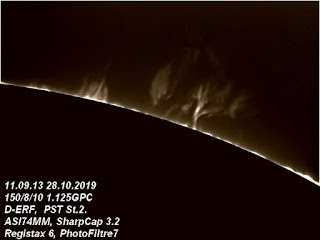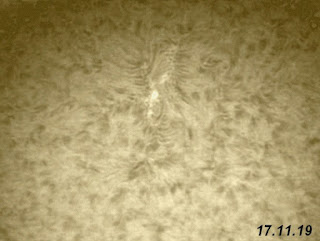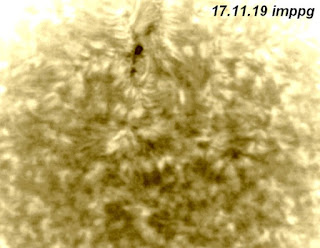*
For high resolution, solar imagery, aperture wins. Though always within the limitations of local seeing conditions. The larger the aperture the more the atmosphere can interfere. This is the result of the physical size of thermal convection cells. Also because of the inevitably higher magnifications involved. Unless optical means is used to reduce the focal length, the camera sensor is fixed in power or image scale.
The larger solar telescope will provide unprecedented detail but only when seeing conditions favour it. Which suggests a fall-back, smaller instrument for all those occasions when the seeing does not cooperate. Which makes the considerable investment in the larger instrument even more doubtful.
The present "quiet sun" offers reduced opportunity for any instrument to capture noticeable surface detail. [Active Regions or Sunspots] Though the larger aperture can capture what passes unnoticed in a smaller telescope.
When only prominences are available for solar interest then the larger instrument can really get into its longer stride. Surface detail might also be lifted to the point where it becomes far more interesting in itself. Where a small instrument cannot possibly reach the level of detail required. All of this is largely determined by the skill of the imager with his choice of processing software.
Larger instruments concentrate a lot more heat. Which must be managed by safe filtration. Inevitably that raises the argument for full aperture D-ERFs to protect the instrument from excessive heat. With some reservations about the internal thermal conditions within the instrument. In theory the air itself shouldn't be warmed by the hot beam from an unfiltered objective.
In practice there are "things" in the way which will almost certainly absorb some heat from a hot, focused beam. The nearer the optical element is to the focal plane the greater concentration of heat.
I can safely [?] vouch for the fact that my 6" lens focuses a lot of heat. Some of which passes right through the internally placed 90mm D-ERF. [Rejection filter.] I can still burn my hand if I place it in the focused beam without the PST etalon and following filters fitted.
Is this entirely the fault of the sub-aperture D-ERF? For all I know the D-ERF, with its multiplicity of deposited layers, is designed to work properly, only on parallel light. The light emerging from the f/8 objective is far from parallel. Which might suggest that the filter cannot perform optimally. Baader clearly recommends placement of their D-ERFs in front of the objective. NOT somewhere behind it.
Well, they would say that wouldn't they? The cost of D-ERFs rises rapidly with increasing diameter. You can buy an achromatic objective [even a complete ED OTA] for less than the price of a larger, Baader [or Airies] D-ERF. That doesn't mean the filter manufacturer's safety advice is wrong, of course. It is eminently sensible and provides a level of safety for all users. Perhaps one not enjoyed by the cost-cutting sub-aperture, filter users, like myself.
There is a move towards Schmidt Cassegrain telescopes for solar H-alpha imaging. The problem is obtaining a full aperture D-ERF within one's budget. There is only one manufacturer [Aries] and the costs are frightening for mere mortals wanting to try these larger apertures. These instruments can't be used with internal, sub aperture filters because of their design. The secondary would be cooked by the concentrated beam from the large mirror even if the filter could be placed anywhere useful.
Where does that leave me with my desire for more surface detail and increased scale for prominences? I have my 7" f/12 R35 iStar objective. Presently only used for white light imaging with a Lacerta 2" prism. The iStar has a focal length 1.44 x that of the Celestron CR150HD f/8 which I presently use for H-alpha. 2160:1500 [with GPC.] Given my experience of a hot beam from the 6" the extra heating from the 7" could be considered a serious problem.
I would like to use the 7" in its folded form to reduce the far greater moment of the long tube version. While the beam folding, optical flats of the 7" are of Zerodur, I really don't want them being baked for literally hours every day it is sunny by the 7" objective. Which means selling several kidneys for a 180mm D-ERF. Ouch!
The much more compact, folded 7" framework would give me a more solid base to support the extended stack of the PST etalon and following filtration. Provided with motor focusing and etalon tuning, there would be no need to handle the telescope during imaging sessions. A 2" star diagonal could turn the final leg of the beam upwards for a really solid attachment to the OTA.
*

 Tuesday 31st 41F. A rare cloud-free start to the day though breezy from the west. As I enjoy morning coffee I am watching the shadows of a neighbour's trees descend slowly down the dome. 10.00am and the shadows are still covering the lower half. The wind is supposed to turn north westwards. So I should be free of the telescopes shaking when I eventually get a clear view of the sun. The trees behind the dome are rocking and my large, but obsolete, Met Office anemometer has just started to twirl. Always a sign of a good breeze. The forecast is for 25mph gusts but falling slowly all day.
Tuesday 31st 41F. A rare cloud-free start to the day though breezy from the west. As I enjoy morning coffee I am watching the shadows of a neighbour's trees descend slowly down the dome. 10.00am and the shadows are still covering the lower half. The wind is supposed to turn north westwards. So I should be free of the telescopes shaking when I eventually get a clear view of the sun. The trees behind the dome are rocking and my large, but obsolete, Met Office anemometer has just started to twirl. Always a sign of a good breeze. The forecast is for 25mph gusts but falling slowly all day. Carried on capturing videos until 12.30 and early lunch. Sharpness is poor as can be seen from the image. Even after beating it to death with iMPPG and PhotoFiltre I couldn't bring out the smudge visible on Gong H-a.
Carried on capturing videos until 12.30 and early lunch. Sharpness is poor as can be seen from the image. Even after beating it to death with iMPPG and PhotoFiltre I couldn't bring out the smudge visible on Gong H-a. 








